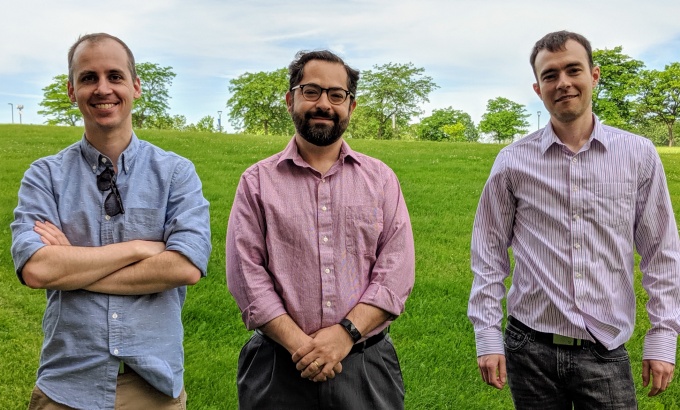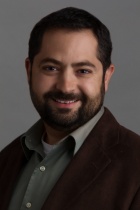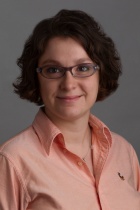Faculty News

CAREER Awardees – Prof. Timothy Cook, Prof. Luis Velarde, and Prof. David Lacy
In 2018 and 2019, three Chemistry faculty received National Science Foundation (NSF) CAREER Awards, the agency’s most prestigious accolade for early-career investigators: Prof. Luis Velarde, Prof. Timothy Cook, and Prof. David Lacy. Eleven faculty from the department have now won CAREER Awards since the inception of the program in the mid-1990s.
The following overviews are adapted from UBNow articles written by Charlotte Hsu.
Prof. Luis Velarde: Sum-Frequency Generation Spectroscopy. Velarde’s $665,000 CAREER grant will support his work on creating spectroscopic tools to speed development of materials for energy storage, medical imaging, sensing and more.
Velarde joined UB in 2013. His lab is analyzing the interfacial region of nanoparticles and unveiling how molecules on a particle’s surface interact with and bind to molecules and ions in the area directly around the particle. Such cooperative interactions are critical in determining how the particles function when suspended in electrolyte solutions and gels.
“This is a fundamental area of study that is often neglected,” Velarde says. “The chemical and electrical properties of the entire interfacial region are very important. They determine the fate, function and processing of new nanomaterials.”
The NSF funding will also enable Velarde to design kits containing materials that K-12 students can use to build devices for detecting various particles. These student-designed sensors will be used in classroom activities that teach scientific principles tied to light, electronics and nanomaterials — all of which are relevant to Velarde’s research.
Prof. Timothy Cook: Coordination-Driven Self-Assembly. Cook, who joined UB in 2014, is using $675,000 in CAREER funding to design and study self-assembling molecules that can catalyze reactions in hydrogen fuel cells or reduce carbon dioxide.
Through self-assembly, Cook’s team can synthesize supramolecular catalysts that would take weeks or months to make using conventional syntheses.
“Our lab does self-assembly chemistry. You mix things together and you make new molecules,” says Cook. “One of the neat things about self-assembly is that you can explore the properties of many different molecules quickly. We can make small changes very systemically. We can change how far apart certain atoms are, how big the final molecule is and how it’s shaped.”
Cook will also work with K-12 science teachers in Buffalo to design 3D-printed structures made from magnetic parts that self-assemble when they’re shaken together in a beaker or other container. These models are a fun, hands-on way of teaching chemistry, as they enable students to visualize processes similar to those occurring in real life when scientists design self-assembled molecules.
Prof. David Lacy: Manganese Complexes as Earth-Abundant Catalysts. Lacy’s $650,000 CAREER award will support his development of manganese-containing compounds that could replace ruthenium-derived counterparts.
“Our work in developing manganese-based catalysts will enable new sustainable chemistry by replacing toxic and expensive ruthenium-based catalysts that are currently in use,” says Lacy, who joined our faculty in 2015. “Manganese shares some of the properties of ruthenium and other transition metals, but it also has some interesting and unique chemical and electronic properties of its own.”
Professor Ekin Atilla-Gokcumen and Professor Luis Velarde were promoted in 2019 to associate professor with tenure! We are fortunate to count them among our tenured faculty.

Prof. Luis Velarde
Prof. Velarde arrived at UB in fall 2013 following postdoctoral studies at Pacific Northwest National Laboratory and UC Santa Barbara, and graduate work at the University of Arizona. Prof. Velarde has built a cutting-edge research program focused on developing vibrational sum-frequency generation (SFG) spectroscopy and using the technique to characterize nanostructured surfaces and interfaces. Prof. Velarde and his team have exploited the interface-selectivity of SFG to characterize the organization and orientation of surfactants on carbon nanotubes, organic dye molecules on gold nanoparticles, and pesticides on silica surfaces. They have also performed pioneering work to develop and refine doubly-resonant SFG as a spectroscopic technique. This research has been published in a series of recent articles in leading journals of physical chemistry. Prof. Velarde won the prestigious CAREER Award from the National Science Foundation in 2018, and he is principal or co-principal investigator on two other NSF grants. Prof. Velarde has mentored multiple PhD graduates and has taught undergraduate and graduate courses in physical chemistry, materials chemistry, and general chemistry. He has enthusiastically contributed in service to the department and university.

Prof. Ekin Atila-Gokcumen
Prof. Atilla-Gokcumen arrived at UB in fall 2013 following postdoctoral research at the Dana Farber Cancer Institute and graduate studies at the University of Pennsylvania. Prof. Atilla- Gokcumen has established a prolific research program at UB involving mass spectrometry-based analysis to elucidate the roles of lipids in regulating cellular fates in biology. She and her team have identified lipids associated with necroptosis, apoptosis, and replicative senescence, and have unraveled molecularlevel mechanisms by which lipids regulate such processes. Prof. Atilla-Gokcumen has already obtained six federal grants in support of her research program, as principal investigator or co-investigator, and she and her team have published 20- plus peer-reviewed publications. The first PhD alumni of the Atilla-Gokcumen group graduated within the past year. Prof. Atilla-Gokcumen has taught a range courses in the department’s undergraduate and graduate medicinal chemistry programs and has served the department ably in a number of roles.